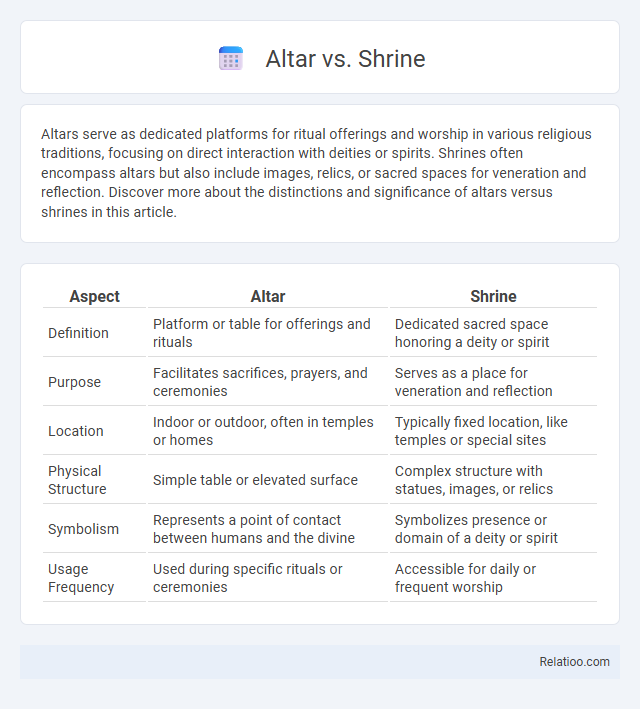Altars serve as dedicated platforms for ritual offerings and worship in various religious traditions, focusing on direct interaction with deities or spirits. Shrines often encompass altars but also include images, relics, or sacred spaces for veneration and reflection. Discover more about the distinctions and significance of altars versus shrines in this article.
Table of Comparison
| Aspect | Altar | Shrine |
|---|---|---|
| Definition | Platform or table for offerings and rituals | Dedicated sacred space honoring a deity or spirit |
| Purpose | Facilitates sacrifices, prayers, and ceremonies | Serves as a place for veneration and reflection |
| Location | Indoor or outdoor, often in temples or homes | Typically fixed location, like temples or special sites |
| Physical Structure | Simple table or elevated surface | Complex structure with statues, images, or relics |
| Symbolism | Represents a point of contact between humans and the divine | Symbolizes presence or domain of a deity or spirit |
| Usage Frequency | Used during specific rituals or ceremonies | Accessible for daily or frequent worship |
Understanding Altars: Definition and Purpose
Altars serve as designated platforms or structures for offering rituals, worship, and sacrifices in various religious and spiritual practices, symbolizing connection between the divine and worshippers. Shrines, often housing sacred objects or relics, function as places of veneration and remembrance, distinct from altars by their emphasis on honoring specific deities or saints. Understanding altars involves recognizing their central purpose in ritual acts, facilitating spiritual communication, and embodying sacred space in contrast to the broader commemorative role of shrines.
What is a Shrine? Key Characteristics
A shrine is a sacred place dedicated to a specific deity, ancestor, or religious figure, often housing relics or icons for worship and veneration. Key characteristics include its function as a site for pilgrimage, prayer, and offerings, usually marked by symbolic elements like statues, candles, and inscriptions. You can distinguish a shrine from an altar by its broader role as a location honoring a deity or saint rather than solely serving as a surface or structure for ritual acts like sacrifices or offerings.
Historical Origins of Altars and Shrines
Altars and shrines have distinct historical origins rooted in ancient religious practices; altars originated as raised platforms for sacrifices and offerings in various ancient cultures, symbolizing a sacred space for divine interaction. Shrines developed as dedicated structures or places honoring deities, ancestors, or saints, often housing relics or images to facilitate worship and pilgrimage. Understanding these origins helps you appreciate how altars function primarily as active ceremonial sites, while shrines serve as permanent devotional spaces.
Altars in Various Religious Traditions
Altars serve as sacred platforms in numerous religious traditions, acting as focal points for offerings, prayers, and rituals that connect worshippers with the divine. In Christianity, altars often symbolize the presence of Christ and are central to the Eucharist, while in Hinduism, altars house deities' images and facilitate daily worship (puja). Understanding your altar's role within your specific spiritual practice enhances reverence and deepens your connection to the sacred space.
Shrines Across Cultures and Faiths
Shrines serve as sacred spaces dedicated to specific deities, ancestors, or revered figures, often reflecting unique cultural and religious symbolism across faiths such as Buddhism, Hinduism, Christianity, and Shintoism. Unlike altars primarily used for offerings and rituals, shrines encompass a broader spiritual significance, acting as pilgrimage destinations and community focal points for worship and meditation. The architectural styles, rituals performed, and the artifacts housed in shrines vary widely, illustrating the diverse ways cultures honor the divine and preserve spiritual heritage.
Structural Differences: Altar vs Shrine
An altar is a flat, elevated surface primarily used for offerings, rituals, or sacrifices, often found in churches or temples with a simple, functional design. Shrines, by contrast, are enclosed or semi-enclosed structures that house sacred objects or deities and offer a more elaborate, decorative setting for worship and reflection. Understanding these structural differences helps you choose the appropriate space for specific religious or spiritual practices.
Rituals Performed at Altars and Shrines
Rituals performed at altars often involve offerings, prayers, and sacrifices to deities or spirits, serving as a focal point for worship and ceremonies in various religious traditions. Shrines typically host rituals that honor specific saints, ancestors, or sacred objects, including lighting candles, placing flowers, and reciting invocations to seek blessings or protection. Your engagement with these sacred spaces depends on the ritual's intent--altars emphasize active worship and communion, while shrines focus on veneration and remembrance.
Symbolic Meanings: Altar vs Shrine
Altars symbolize a sacred space for offerings and rituals, serving as a direct connection between You and divine forces. Shrines represent a dedicated place of reverence and remembrance, often housing icons or relics linked to specific deities or ancestors. The symbolic difference lies in altars facilitating active worship, while shrines embody devotion and protection.
Contemporary Uses of Altars and Shrines
Contemporary uses of altars and shrines vary significantly, with altars primarily serving as focal points for personal rituals, meditation, and spiritual offerings, often found in homes or places of worship. Shrines, on the other hand, are dedicated spaces honoring specific deities, ancestors, or saints, frequently used for public veneration and communal ceremonies. Your choice between an altar and a shrine depends on whether you seek a private spiritual practice or a communal and devotional environment.
Choosing Between an Altar and a Shrine
Choosing between an altar and a shrine depends on your spiritual practice and available space; altars typically serve as personal, functional surfaces for offerings and rituals, while shrines often encompass a more elaborate, dedicated space honoring deities or ancestors. Your intention for use--whether daily worship, meditation, or ceremonial purposes--guides the decision, as altars are more versatile and compact, whereas shrines provide symbolic architecture and a focal point for communal or traditional veneration. Consider the materials, size, and cultural significance to ensure your sacred space aligns with your spiritual needs and aesthetic preferences.

Infographic: Altar vs Shrine
 relatioo.com
relatioo.com